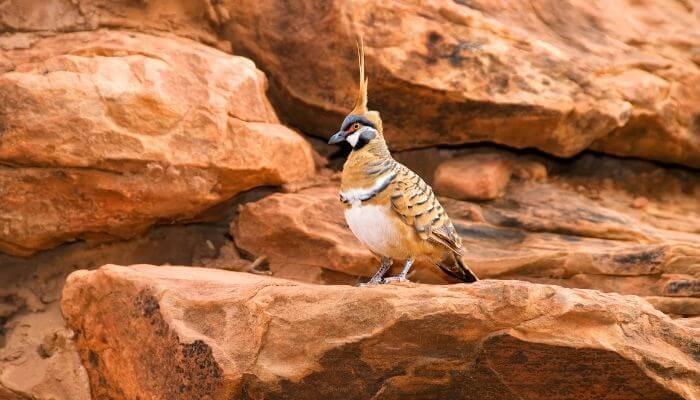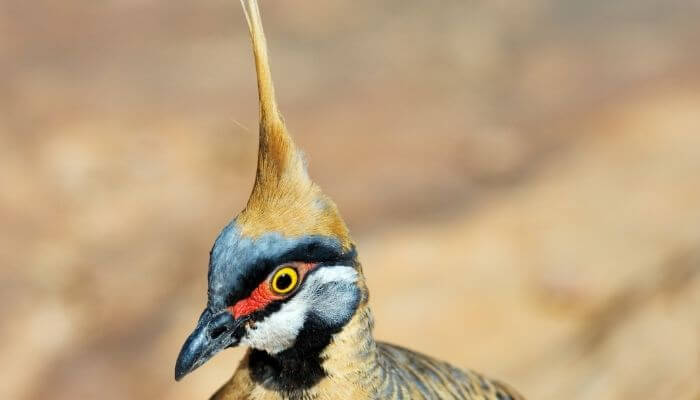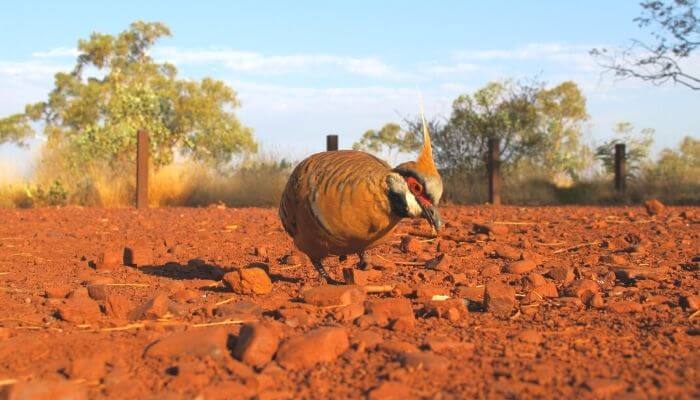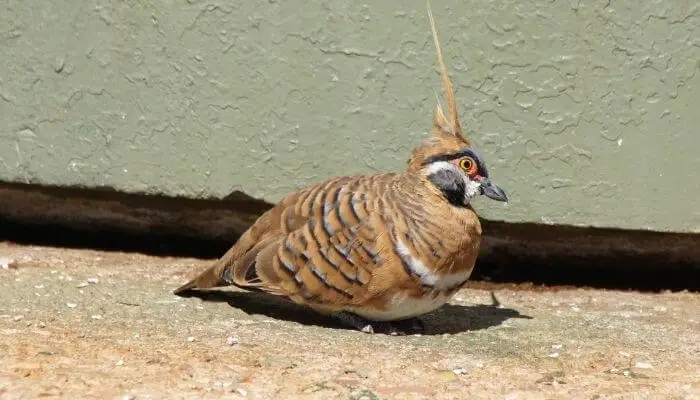Spinifex pigeons are unique birds that have special wings that take a mohawk-like shape, which allows them to make a loud whistling sound.

This sound is used as a warning beacon to all other birds on the ground to notify them if there are predators nearby and to draw predators’ attention upwards and away from the birds on the ground.
Origin, Residence, and Migration Of The Spinifex
Spinifex birds belong to the Geophaps genus and are part of the family Columbidae.
They’re one of four endemic bird species in this genus within Australia (Australia also has 20 native species of pigeon including the Wonga pigeon and Bronzewing pigeon).
These pigeons are native to Australia and can’t be found anywhere else.
They mostly reside in northern and central Australia.

You can find them in areas that have rocks, mountains, creek beds, and grass, especially spinifex grass.
You’ll also find them in areas that have some sort of water source because they don’t travel very far and don’t search for water sources often.
They don’t usually migrate either because, as we mentioned, they keep close to water sources.
They do, however, change between flocks.
A group of spinifex pigeons might leave their current flock to spend some time in another flock and then return.
Think of them as temporary friendly visits.
Another fact about spinifex pigeons is that they’re not loners.
You’ll always find them in a pair or in groups. If you’re lucky, you might spot a whole flock of 400 moving together.
Spinifex Pigeon Appearance and Size
One of the most noticeable features of spinifex pigeons is their mohawk-like structure.
It gives them a very distinctive look—stylish too!

In terms of color, these birds come in shades of rufous-brown and their wings and back have thin, bar-like black patterns.
| Wingspan | Length | Weight | Coloring | |
|---|---|---|---|---|
| Spinifex Pigeon | 30 – 35 cm | 20 – 23.5 cm | 80 – 110 g | Rufus-brown with some gray and white stripes |
| Average Feral Pigeon | 64 – 72 cm | 32 – 37 cm | 300 – 500 g | Bluish grey with some black |
The majority of them have white bellies but some of their subspecies have brown bellies as well.
Their bills and throats are a shiny black color, and the sides of their crowns and foreheads are a pale gray shade.
Their legs and feet are also in shades of gray, however, in the middle of these gloomy colors, their face has a combination of bright red shades that glow things up.
They also have some unique color features.

For example, the edge of their face has a shiny black stripe that looks like a frame and there’s a white stripe that stretches from their chins to the back of their eyes and another white stripe that’s visible across their chests.
When it comes to size, spinifex pigeons are definitely smaller than your average pigeon.
Their length is around 20 to 23.5 cm, with a wingspan of 30 to 35 cm, and they weigh around 80 to 110 grams.
On the other hand, an average feral pigeon’s length is around 32 to 37 cm, and they have a wingspan of 64 to 72 cm.
Their weight can be anywhere between 300 to 500 grams.
Diet and Domestication
Spinifex pigeons’ diet mostly consists of herbs and seeds.
And because they spend a lot of time in areas that have spinifex grass, they consume a lot of it as well.
As for what insects they can snack on, they can eat different species of worms and ants.

Unlike other pigeon species like the Rock Dove, Spinifex pigeons can’t be kept as pets.
However, you can find them at national parks and reserves kept as protected animals.
They may even accept some treats from you if you run into them during your camping trip.
Reproduction and Lifespan
Mating season for spinifex pigeons begins in spring when the weather warms up in August, until early summer in January.
The eggs are known to have a cream-like white color and females usually lay two eggs every breeding season.
Spinifex pigeons nest mostly on the ground during the breeding season, and both males and females take shifts in the nesting duties and both of them participate in the incubation of the eggs.
The incubation process lasts for about 16 to 18 days.
After the eggs hatch, the newly hatched chicks will need around six to nine days to start walking and running, and then they learn to fly after about 11 days.
At that time, they say farewell to their parents and leave the nest.
There’s no available record of the exact time span of spinifex pigeons specifically.
However, pigeons in general, have a lifespan of 6 (more typical in the wild) to 15 years (generally pigeons won’t live this long unless they are kept in captivity).
Are Spinifex Pigeons Rare?
Spinifex pigeons are put in the “Least Concern” category by the International Union for Conservation of Nature (IUCN).

They can be found in great numbers in different parts of Australia and they’re multiplying at a steady rate. So don’t worry, these guys aren’t going anywhere!
Conclusion
From their tiny size to their beautiful colors and unique shape, spinifex pigeons are definitely beautiful-looking creatures, and it’s a good thing to know they’re going to be around for a long time!
